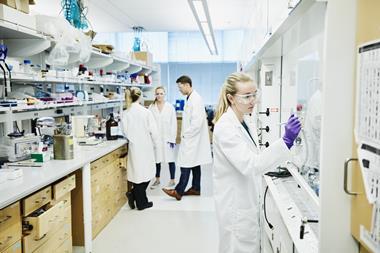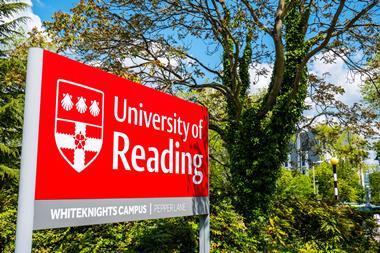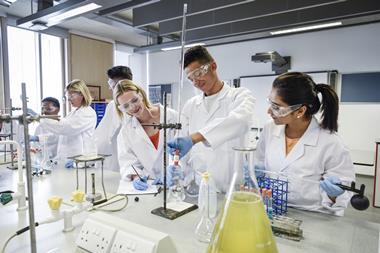More students in the UK are studying chemistry at A-level than 20 years ago, but how does that translate to universities?
In the very first issue of Chemistry World, Nobel laureate and former Royal Society of Chemistry (RSC) president Harry Kroto highlighted the need to address the decline in popularity of studying chemistry and find ways to ‘revitalise teaching’. His warning came following a 25% drop in the number of undergraduate chemists over the previous five years, which, he said, had serious implications not only for university chemistry departments but also for the future of the UK.

‘A number of institutions that had very good chemistry departments decided not to carry on,’ recalls Robert Mokaya, provost and deputy vice-chancellor at the University of Sheffield and president-elect of the RSC. ‘At that point it was felt that if that was a trend that was going to continue, it was really going to deplete the numbers who were engaged in the chemical sciences.’
‘I had friends in other universities where the chemistry department closed and we had “refugee chemists”, who joined our department from departments that closed,’ says Caroline Dessent, who heads up the chemistry department at the University of York. ‘There was definitely a huge concern in the community at that point in time and that was really focused on money. It was about universities making decisions, saying that chemistry was a very expensive subject to run.’
Two decades on and with chemistry departments once again under pressure there are warnings that the field has come full circle. But do the numbers reflect this – has the health of the chemistry pipeline improved since 2004?
Chemistry at school
Over the past 20 years, the number of students taking A-level chemistry has increased significantly – from 32,130 in 2004, to 55,512 in 2023. Around 2016, the number of female applicants to A-level courses began to overtake the number of male applicants for the first time and the gap between genders looks set to increase further if numbers follow current trends.
Similar patterns can also be seen in numbers for Scottish Higher qualifications, although the overall number of applicants has remained fairly steady over the past 20 years.
But Kristy Turner, a lecturer in the department of chemistry at the University of Manchester and a chemistry teacher at Bolton School in the UK, attributes the increase in the number of female A-level chemistry students to the number of degree programmes that require chemistry A-level.
‘If you look at the correlation with the entrance in terms of gender for things like medicine, pharmacy, dentistry, they’ve also gone very female as well,’ she says. ‘If suddenly all the medical schools in the country decided they didn’t want chemistry A-level, our numbers would drop massively.’
To attract more students to study A-level chemistry, Turner says the GCSE curriculum should be ‘slimmed down’ because currently some students are having a ‘miserable experience’ doing GCSE science. She also says there is a need to change the focus away from students getting top grades.
‘There is an issue nationally with the idea that any grade below a B is not worth it,’ she says. ‘Universities have a huge part to play in this as well, because many of them tell us that they all require three A’s, and they don’t. [Chemistry] is perceived to be a difficult A-level and it is, but that’s why it’s respected; if you have the resilience to get through it when it seems hard at the start, most people will be fine … for some students, a grade D is a fantastic achievement.’
Our subject is so valuable, so many graduate recruiters want students of chemistry
Reflecting on the teaching of chemistry itself, Turner highlights that many teachers are now teaching outside of their specialism – something she too has done in the past. ‘Now I only teach chemistry, and I can see the difference it’s made in terms of how much better a teacher I am … I can add that colour and that life to my subject, because I know it inside out – I can’t do that so much with biology and physics. Ideally, you shouldn’t be teaching anything to GCSE if you don’t have an A-level in it.’
Overall, Turner says she is worried about the future of chemistry, particularly considering recent university department closures. But she stresses that for change to happen more needs to be done to highlight the value of studying chemistry, not just to become a chemist, but as a valuable stepping stone to a whole variety of careers.
‘The emphasis on doing chemistry to be a chemist is actually unhelpful to us,’ she says. ‘Our subject is so valuable, so many graduate recruiters want students of chemistry – we need to be selling that because, along the way, we will get the accidental chemists who end up being the next Nobel laureate.’
Chemistry at university
Data on the number of applications to chemistry undergraduate courses (one student can apply to up to five courses) show a significant increase from 20,465 in 2007 to 29,350 in 2023. The number of accepted applicants has also increased with numbers rising from 3555 in 2007 to 5205 in 2023.
However, it is clear a significant number of those taking A-level chemistry do not go on to study it at degree level; there was a 58% increase in students taking A-level chemistry between 2007 and 2023 compared to a 46% increase in the number accepted onto degree courses over the same time period.
Wendy Brown, head of the Heads of Chemistry UK, says the increase in accepted applicants to undergraduate chemistry courses could just be because more students go to university in general now ; according to figures from the Higher Education Student Association the total number of HE enrolments at UK HEIs stood at 2,306,105 in 2007/08 compared to 2,936,050 in 2022/23; an increase of 27%.
From her perspective, chemistry has been struggling to maintain numbers of undergraduates in recent years. There have been several closures and openings of departments over the past two decades – most recently this year Reading, Hull and Aston have all proposed closing their chemistry department or courses and it has been warned that more could follow without a significant cash injection.
‘Universities’ financial situations are slightly tricky at the moment,’ says Brown. ‘And chemistry is an expensive subject because it’s lab based – you have to have the chemicals for students to use, but you also have to have the demonstrators in the lab for safety reasons … and then you have fume hoods to get rid of the nasties from any dangerous chemicals, etc.’
Brexit and issues with UK visas have also had a huge impact on university recruitment and finances, Brown says. ‘Brexit has massively changed the number of European students that come to the UK to study chemistry, because they now have to pay overseas fees,’ she says, adding that they can be two and a half to three times the amount UK students pay. ‘It’s a real problem for PhDs, because previously PhD students from the EU could come here on the same fees, which would usually be funded by a grant, and now they have to pay overseas fees.’
Visa problems have also affected master’s courses. ‘All universities have noticed a 40–50% decrease in applications this year for the one-year, postgraduate taught master’s because of the change in the visa where students cannot bring dependents,’ Brown explains
Brown says that ultimately university fees are not enough, and to ensure universities become financially sustainable fees need to increase or the government needs to allocate more funding to higher education. ‘It’s predicted that in the next few financial years, more than half of universities will be reporting financial deficits,’ she says. ‘We are trying to be hopeful that the new government will start to look at things.’
Brown also agrees with Turner that more work needs to be done to make teachers and students at secondary schools aware that many of the skills from a chemistry degree are transferable. ‘We somehow need to get our message across that a chemistry degree doesn’t only open the door to being a chemist,’ she says. ‘Many universities have been revamping their curriculum lately and focusing more on skills – not just skills of making a molecule in the lab – analytical skills, numerical skills, communication skills, problem solving, etc, all of which are transferable.’
Diversity in chemistry
The field of chemistry has long been dominated by white, able-bodied heterosexual men, and while many universities and academic organisations now have dedicated inclusion and diversity programmes that likely did not exist in 2004, the data suggests that the effects of this work are yet to come through.
Mokaya says universities are now ‘very aware’ that having an inclusive and diverse community is ‘a positive thing’. ‘It makes the community more vibrant and there are indications that universities are putting a spotlight on it in various ways, but it is one of those things that will take some time to change, because unfortunately not everybody is a believer that this is a positive thing.’
According to the most up-to-date figures from HESA, most chemistry professors are still white, male and between 51–65 years old. Members of senior management in chemistry departments tend to be slightly younger but the trends are predominantly the same.
At the student level the story is slightly better but student groups are still dominated by white, able-bodied students. Dessent, who is strongly committed to improving the participation of minority ethnic scientists in academia, describes the overall lack of progress over the past two decades as ‘very disappointing’.
‘[Lack of diversity] is a huge issue in the chemistry community,’ she says. ‘It definitely impacts on younger career researchers that are from ethnic minority groups, there’s no doubt about that, and almost certainly into the undergraduate students that we can recruit – it’s a real worry.’
But Dessent explains that the lack of diversity in the subject has only been recognised relatively recently. ‘I don’t think we’ve made a lot of progress over 10 years. But to be honest, I don’t really think we’ve been trying for much longer than about two years as a community.’
She references the Royal Society of Chemistry ‘Missing Elements’ report, which, in 2022, identified that less than 1% of principal investigators across all subjects in UK academia were black; at the time Mokaya was the only black professor of chemistry and had been since 2008.
‘Some of the actions that came off the back of that [was to] set up the Missing Elements Grants Scheme [and] a mentoring scheme for minority ethnic individuals,’ she says. ‘The Royal Society has just started an early career fellowship for black researchers – the Wellcome Trust were the first ones to do a scheme like that but that was probably only two years ago.’
Dessent says it will probably be at least five years before the effects of that work are reflected in the diversity data. ‘There’s more commitment from the community around this. There’s an understanding and a realisation that there’s a lot of work to be done there and that there are individuals who could be exceptional chemists who we are just losing.’
We need to move from talking about diversity to actually doing things
Mokaya says that while several initiatives have been introduced to support those in ethnic minority groups there is a need to link them with people’s lived experiences. ‘We are still yet to make that connection,’ he says. ‘If the initiatives do not change people’s lived experience and people’s sense of belonging, then actually they are missing the point,’ he adds.
Dessent says that her biggest concerns are for those students who from both ethnic minority groups and lower socioeconomic groups. ‘We know they’re underrepresented in chemistry and they drop out at greater rates,’ she says. ‘In some ways, money is the very hardest thing around diversity to try to deal with because it’s so constrained.’
Dessent believes chemistry needs to address the barriers the subject presents to disabled people. She says that, from an early point, some disabled students may feel that the lab-based nature of the subject makes it inaccessible. ‘For a student who does have mobility challenges, they’re probably already put off chemistry a bit, but there’s some really good work from the community around this … [but] when you think about how many people do have a disability or are going to have a disability across their lifetime, that’s a significant challenge.’
Mokaya says the chemical sciences community is still addressing the issue of access and although some change has been made there is ‘still some distance to travel’. He believes that chemistry will continue to be needed but acknowledges that the subject is currently under ‘threat’. ‘The conversations we are having now about the importance of being inclusive and diverse are really important … [but we need to move] from talking to actually doing things and recognise that that is not going to be done by one sector only, or one organisation.’
Looking to the future
Many of the departments closed in 2004 have since reopened but chemistry remains an expensive subject to teach and more funding is needed to ensure departments can continue to offer it to their students. But, as was the case 20 years ago when Kroto raised his warning, work needs to be done to revitalise teaching and address the decline in chemistry’s popularity among students.
Turner remembers the investment that was made in the 2000s to encourage students to consider studying chemistry, such as the Chemistry for Our Future programme that was launched in 2006. ‘That’s kind of how my teaching career started, with this really big focus [on encouraging students to study chemistry]. There was lots of outreach, there were lots of resources,’ she says. ‘I remember, as a newly qualified teacher, being involved in a Royal Society of Chemistry project to match up the A-level curriculum with the first-year university curriculum; there were some really great projects around that were about connecting teachers with universities.’
There’s no point having 6500 new teachers if there are no experienced teachers
But, with university and government finances as they currently are it’s difficult to see where the money for improvements would come from. And, as Mokaya highlights, 17- and 18-year-olds now get their information from a much wider range of sources resulting in some subjects becoming much more ‘in fashion’ than others. ‘There was a time when the main person that provided information about what you should study was teachers,’ he says. [But now] trends outside of academia can affect what young people want to study.’
Mokaya, Dessent, Brown and Turner all agree that the subject needs a makeover to highlight that studying chemistry can provide the skills to open a variety of doors, not just those leading to a career as a chemist. ‘The RSC’s accreditation is looking more at skills now, and many universities have been revamping their curriculum lately and focusing more on skills,’ says Brown.
Ultimately, the journey for our next generation of chemists starts at school and one of the biggest motivators for students to study a subject is in having teachers who are passionate about it. ‘The Labour Party is telling us we need 6500 new teachers…[but] there’s no point having 6500 new teachers if there are no experienced teachers,’ says Turner. ‘There is nowhere, in terms of esteem and salary, where a committed subject specialist is rewarded in that respect.’
The improvements seen since 2004 show that change is possible, but it is clear that there is still significant work – and money – needed to boost the health of chemistry for the next 20 years.
Data sources
A-level student data obtained from the UK Department for Education, rounded to nearest 1000. All other data from HESA, processed according to Jisc standard rounding methodology. The HESA data is copyright Jisc 2024. Neither Jisc nor Jisc Services Limited can accept responsibility for any inferences or conclusions derived by third parties from data or other information supplied by Jisc or Jisc Services Limited.
Downloads
Harry Kroto's article from January 2004
Article | PDF, Size 0.85 mb

















No comments yet